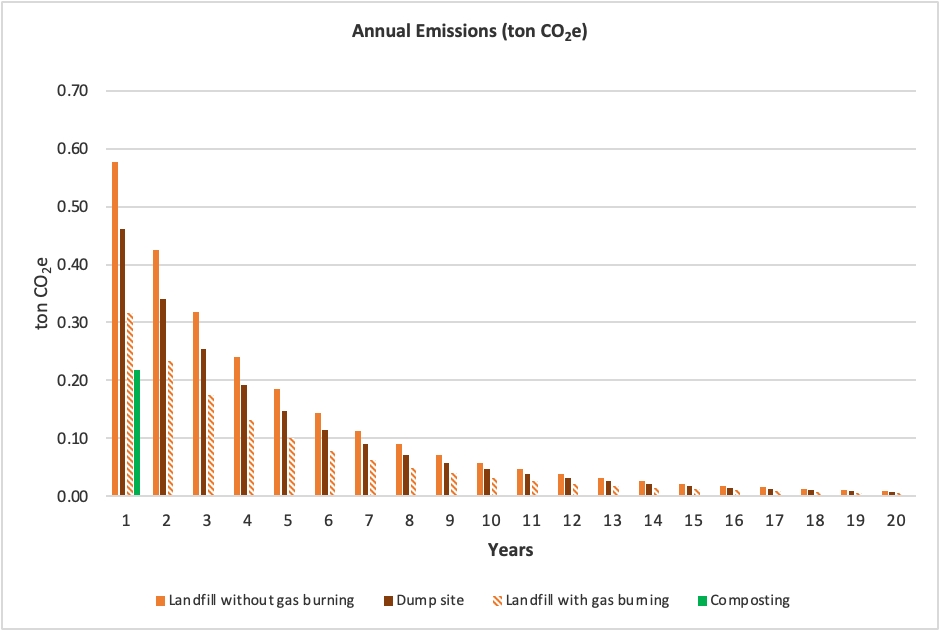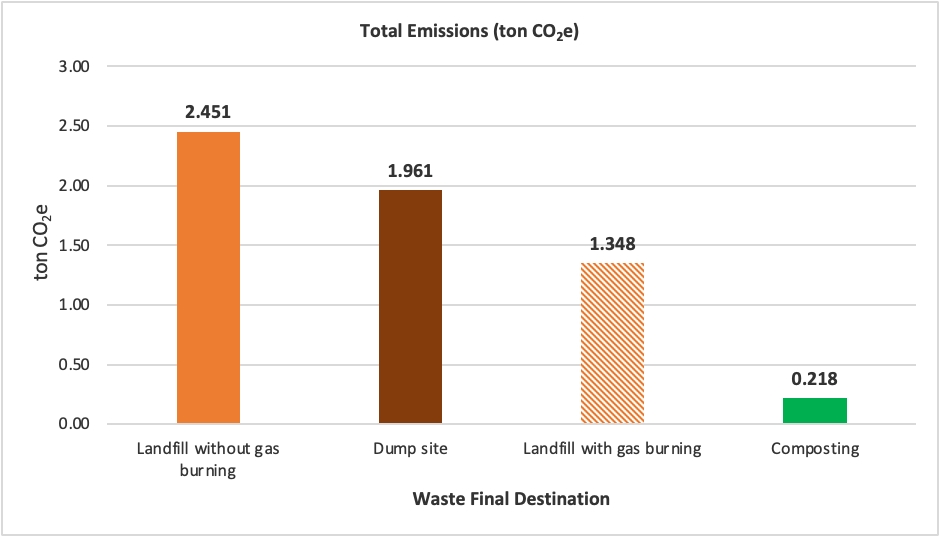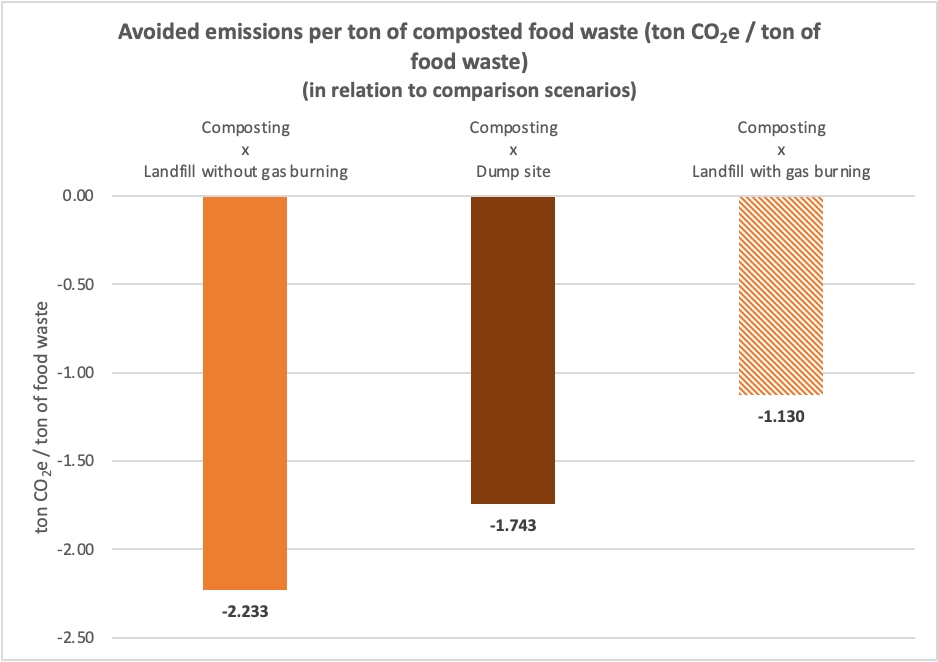Carbon Credit Tokens from Composting
As previously outlined in the introduction of this White Paper, the current linear economy is tremendously wasteful and the provisioning of food and consumer end products represent 49% of global greenhouse gasses (GHGs), measured on a systems-based approach. A circular economy can have a profound impact on reducing GHGs emissions by eliminating superfluous product supply chains and ensuring biological waste is diverted from landfills and incinerators, and directed toward controlled biological treatment centers, such as composting and anaerobic digestion facilities. Biological waste represents 50% of total waste volumes and all of it could be composted.
This section describes in more detail how GHG emissions avoidance from biological waste recycling (composting in particular) utilizing existing methodologies from the United Nations Framework on Climate Change (UNFCCC), the same that are used for Clean Development Mechanism[70] (CDM) projects, will be used to produce Tokenized Carbon Credits (TCCs.) In the future we will introduce methods to calculate GHG emissions avoidance from recycling of technical products such as plastic, glass, metals, etc. utilizing tools such as the United States Environmental Protection Agency’s (EPA) Waste Reduction Model (WARM.) As outlined before, the Carrot Fndn’s TCCs are a decentralized solution for scaling carbon credits that are backed by digital assets (MassIDs) with Proof-of-Physical-Work, Proof-of-Provenance and certified-recycling.
The method for calculating avoided greenhouse gas emissions involves first understanding the GHGs that are emitted for existing, traditional waste management (to landfills and dumps) and comparing those to an alternative, lower emitting, process such as composting of biowaste.
The environmental benefits of this service (of which there are many, see below), should be priced into each TCC as well as the redistribution of value to each recycling contributor (see $CARROT Distribution). Because methane is so potent and composting so effective in reducing methane emissions (>90%) when compared to baseline alternatives (see TCC Carbon Credits for calculations), the net Carbon Dioxide equivalent (CO2e) result on a per ton basis of biological waste recycled (composted), produces significant value to the business of composting if it can be monetized. The Carbon Credit value, when compared to the total cost of food waste Pick-up, Hauling and and Recycling (Composting) can represent 10-100% of total costs, and serves as a critical new revenue stream that will help grow independent, decentralized composting businesses all over the world.
Let’s understand the benefits of composting. Reducing the “bad and the ugly”:
Reduction of methane (GHGs) emissions at landfills and dump sites;
Reduced contamination by recyclables, improving the sanitary & health conditions for sorters and boosting recycling performance by 2X-5X in recycling centers;
Reduced raw material extraction from improved recycling rates, leading to the preservation of natural resources for future generations;
For municipalities, reduced volumes of waste sent to landfills and incinerators impacts the bottom line directly. Tipping fees at landfills and incinerators, charged on a per ton basis of waste are cut immediately. Costs associated with new landfills are pushed into the future, or even eliminated, as landfill life expectancy is extended.
Reduced biological waste in landfills and incinerators lessen health and environmental costs associated with contamination of soil, water and air and protect local ecosystems;
(For more on the bad see Recycling Systems are Broken.)
Increasing “the good”:
Compost, the output from the work of composting biological waste, is an incredibly valuable, natural, nutrient-rich byproduct that is critical to restoring topsoil and protecting our future food security. According to some at the UN, this topsoil and food security is an even bigger problem than climate change;
Compost provides nutrients to the soil, reducing the need for fertilizers and associated costs;
Compost captures and holds moisture in the soil, reducing the costs of irrigation and the strain on water resources;
Compost stimulates life in the soil, increasing resilience to pests and reducing the need for pesticides, and associated costs;
Fertilizers and pesticides, which typically come in the form of petroleum derivatives, also carry carbon intensive supply chains, which can be eliminated;
Healthy and nutrient-rich topsoil improves plant growth and photosynthesis performance, removing more carbon dioxide from the atmosphere and “sinking” it underground in its roots. The contribution is profound. Composting transforms current biological waste treatment solutions from a net carbon emitter to net carbon sequester (becoming carbon negative[71].)
Composting is a green jobs generator, yielding ~3.5 direct green jobs for every 1 job at a landfill or incinerator. And indirectly, by cleaning up recyclable and reuse streams, composting can generate many more green jobs in the recycling, remanufacturing and repair fields, representing total relative jobs potential of 290.5 green jobs for every one job at a landfill or incinerator, according to Gaia as previously noted
(For more on “the good” see From Linear to Circular and What is Zero Waste?.)
The work of composting must be performed well to maximize methane reduction (which occurs when organic material decomposes aerobically, or, with oxygen). Temperature, moisture and oxygenation must be controlled to ensure healthy microbial activity. The mix of green waste (plant and tree trimmings) with food waste also impacts nutrient composition (carbon to nitrogen ratio) of the compost. For static composting heaps, green waste aggregates serve to hold up the heap while also providing the oxygen access to its inner parts. Because composting heaps can utilize both food waste and green waste in their mix we must account for the methane reduction that happens for each of these biological mass types individually and then add them together in accordance with the weight of mass that was verifiably composted. For the purposes of demonstrating the benefits of composting, we will use a 50/50 food waste-to-green waste composition of compost heaps, the same used in the TCC Calculations section.
The calculation methodology utilized is the UNFCCC’s AMS-III.F (Avoidance of Methane emissions through composting) version 12, in three distinct scenarios (1-3 below), and then compared to composting (scenario 4):
Food waste and green waste decomposition in sanitary landfills that do not have a method for collecting and burning landfill gasses;
Food waste and green waste decomposition in sanitary landfills that do have a method for collecting and burning landfill gasses;
Food waste and green waste decomposition in general dump sites:
Food waste and green waste composting in composting facilities.
The methane emitted in dumps and landfills is calculated using UNFCCC’s CDM, Methodological Tool 04 version 08.0 EB94 tool for determining “emissions from solid waste disposal sites (SWDS)” by applying the following formula:

For more detailed information on the formula and its variables see appendix.
For emission from composting, we utilized the methodological Tool 13, version 02.0, called “Project and leakage emissions from composting” according to the formula:

For more detailed information on this formula and its variables see appendix.
As can be seen from the results below, greenhouse emissions, expressed in terms of carbon dioxide equivalent (CO2e), produced from the disposal of organic waste in sanitary landfills are significantly higher than those arising from composting. Treating (1) ton of food waste by means of composting results in total emission of greenhouse gas equivalent to 0.218 tons of CO2e and/or 218 kilogram of CO2e, and includes the emissions from the tree and plant trimmings used in the process. In the graph below, note that all of these emissions related to composting occur during the first six months and after that produce no emissions, unlike landfills and dumps.
As for the waste disposed of in landfills and dumps, much higher emissions are produced than with composting, with gradual reduction occurring over 20 years following initial disposal.

The scenario of landfill without flaring (methane gas burning) displayed a total 20-year emission of 2.451 tons of CO2e, whereas the dump scenario produced 1.961 tons of CO2e, and finally, the scenario of sanitary landfills with effective methods of gas capture and burning produced 1.348 tons of CO2e (see below).

Comparing the various methods of food and plant waste disposal, we see (in the diagram below) that composting one ton of food waste mixed with one ton of green waste (50/50 ratio) reduces the amount of greenhouse gasses by 1.130 tons of CO2e when compared to disposal in landfills with capture and burning of gasses, by 1.743 of CO2e when compared to traditional dump sites, and by 2.233 tons of CO2e when compared to sanitary landfills without capture and burning of gasses.

In sum, the graph above captures the sizable reduction in CO2e emissions that can be obtained on a per ton basis of food and green waste captured at the source and sent to composting, rather than being driven and buried in landfills and dumps. One ton of food waste and green waste results in more than 1 ton of CO2e emissions reductions in every scenario and much more for sanitary landfills without methane flaring!
Composing Food and Green Waste presents incredible value to the low carbon economy. The price per ton of CO2e avoided though should serve only as a floor value to the Carrot Fndn’s Tokenized Carbon Credit (TCCs), for all of the reasons identified earlier in this section under “The Good, the Bad and the Ugly.” We recognize that carbon credits from burning methane at landfills have a value, but unfortunately the practice itself is not very effective and only addresses ~50% of the methane that is emitted. Methane flaring is only a palliative solution and does nothing to eliminate the underlying problem. In the very near future, incinerators of all types are going to need to buy carbon credits to offset their GHG emissions.
We believe TCCs from composted Food Waste and Green Waste will soon be recognized as the single best Carbon Credits in the world and should capture premium value in the markets. If this value is captured correctly, it will fundamentally change the recycling markets globally, change the lives of hundreds of millions of people, and lead to a significant reduction in overall pollution.
70. United Nations Climate Change - Clean Development Mechanism for certified emissions reduction (CER) credits
71. Carbon Sequestration and Greenhouse Gas Mitigation Potential of Composting and Soil Amendments on California’s Rangelands, report p.1 and p.36 (Silver, Vergara, Mayer)
Last updated